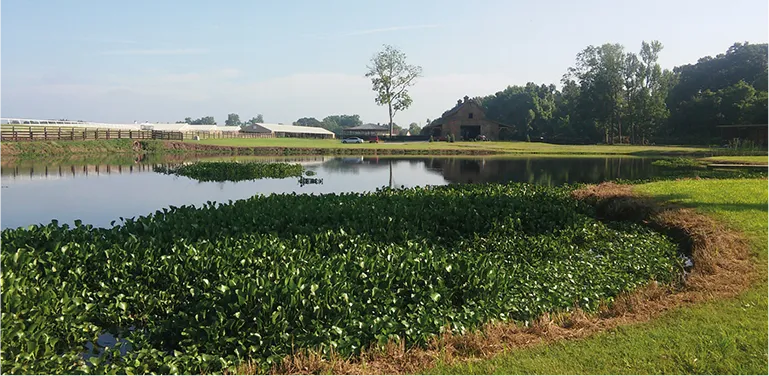Professional Pond Dredging Services in Louisiana

Why Pond Dredging is Essential for Healthy Water
As ponds age, natural processes cause sediment, plant material, and other debris to settle at the bottom. This accumulation can lead to several problems, such as:
- Reduced Water Depth: Sediment buildup gradually decreases the pond’s depth, making it less suitable for fish and leading to rapid temperature changes.
- Poor Water Quality: Decomposing organic matter at the pond’s bottom releases nutrients that encourage algae blooms and lower oxygen levels.
- Increased Invasive Weeds: Shallow ponds with high nutrient levels create ideal conditions for invasive plants like hydrilla, water hyacinth, and alligator weed. These weeds spread rapidly and take over, often blocking sunlight and limiting oxygen for native plants and fish.
Regular dredging addresses these issues, restoring water quality and a balanced ecosystem. Dredging removes built-up sediment, which contains nutrients that would otherwise contribute to invasive weed growth. To learn more about common invasive species that may be affecting your pond, see our Types of Weeds page.
Key Benefits of Pond Dredging
Pond dredging provides several long-term benefits for pond owners in Louisiana, helping maintain a healthy, appealing water feature on your property. Key advantages include:
Improved Water Quality
Excess nutrients from decaying plant material and runoff can lead to murky water and algae overgrowth. By removing this sediment, dredging improves water clarity and reduces the risk of algae blooms. Cleaner water also benefits fish and other wildlife that rely on high-quality conditions to thrive.
Restored Pond Depth and Volume
Pond dredging restores the original depth of the pond, creating more stable conditions that prevent temperature fluctuations. Deeper water allows for more consistent oxygen levels, reduces algae growth, and supports a diverse range of native fish and plants.
Controlled Algae and Weed Growth
Dredging is an effective way to control the growth of invasive plants by removing the nutrient-rich sediment they rely on. Without these nutrients, invasive weeds like duckweed and water lettuce are less likely to take over. This frees up space for native plants, which help maintain a balanced ecosystem and provide food and shelter for local wildlife.
Reduced Fish Kills and Healthier Ecosystem
When a pond becomes too shallow, oxygen levels can drop significantly, leading to fish kills and poor water quality. Dredging removes excess muck and organic matter, keeping oxygen levels stable and reducing the likelihood of fish deaths. A well-dredged pond is also less prone to unpleasant odors, making it more enjoyable for property owners and visitors.
Enhanced Property Value and Aesthetics
A clean, well-maintained pond adds beauty and value to any property, whether residential, commercial, or agricultural. Dredging ensures that your pond remains an attractive, functioning feature, enhancing curb appeal and overall property value.
How Pond Dredging Works
Professional pond dredging uses specialized equipment to remove accumulated sediment and organic matter from the pond bottom. Common dredging methods include:
- Mechanical Dredging: Machines physically scoop out sediment and debris, a method best suited for large or heavily impacted ponds.
- Suction Dredging: This technique involves using a hose to suction out sediment and muck. Suction dredging is effective for smaller ponds and allows for more precise removal.
The method used depends on the size, depth, and condition of the pond, as well as the type of sediment. Pond dredging experts assess each pond to determine the best approach for effective, safe removal that minimizes impact on the ecosystem. For more information on complementary maintenance, visit our Pond Cleaning page.
When to Schedule Pond Dredging
Pond dredging frequency depends on several factors, including pond size, surrounding vegetation, and local conditions. In general, dredging every 5 to 10 years keeps ponds in good shape. However, some ponds may need more frequent dredging if they are located near trees, livestock, or erosion-prone areas.
Signs your pond may need dredging include:
- Decreased Depth: When water depth noticeably decreases, dredging can restore the pond to its original volume.
- Cloudy or Green Water: Poor water clarity and algae growth often indicate high nutrient levels.
- Unpleasant Odors: Foul smells are usually caused by decomposing organic material and can signal the need for dredging.
- Invasive Plant Overgrowth: Rapid growth of invasive plants is another sign of high nutrient levels that dredging can help manage.
By addressing these issues with regular dredging, pond owners can prevent more severe problems and ensure their pond remains a valuable, attractive feature.
Schedule a Free Estimate for Pond Dredging in Louisiana
Professional pond dredging helps Louisiana pond owners enjoy cleaner, deeper, and more ecologically balanced water features. Schedule a free estimate by calling (337) 849-5752 today. Discover how pond dredging can improve water quality, control invasive plants, and enhance your property’s appearance.
